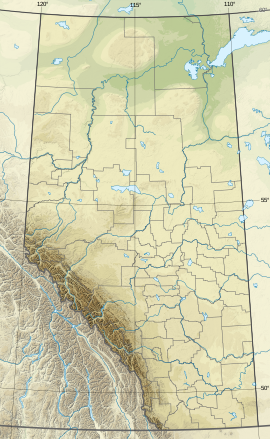| Pinnacle Mountain | |
|---|---|
 Pinnacle Mountain Pinnacle Mountain | |
| Highest point | |
| Elevation | 3,070 m (10,070 ft) |
| Prominence | 225 m (738 ft) |
| Listing | Mountains of Alberta |
| Coordinates | 51°20′20″N 116°13′39″W / 51.33889°N 116.22750°W / 51.33889; -116.22750 |
| Geography | |
  | |
| Interactive map of Pinnacle Mountain | |
| Location | Alberta |
| Parent range | Bow Range Canadian Rockies |
| Topo map | NTS 82N8 Lake Louise |
| Geology | |
| Rock age | Cambrian |
| Rock type | Sedimentary rock |
| Climbing | |
| First ascent | 1909 J.W.A. Hickson, E. Feuz Jr, R. Aemmer |
Pinnacle Mountain is a 3,070-metre (10,070-foot) mountain summit in Banff National Park in Alberta, Canada. It's part of the Bow Range, which is a sub-range of the Canadian Rockies. The nearest higher peak is Eiffel Peak, 1.0 km (0.62 mi) to the southwest. Mount Temple is situated immediately northeast of Pinnacle Mountain, with Sentinel Pass as the low point between the two.
History
The peak was named in 1894 by Walter Wilcox because of large pinnacles on the mountain near Sentinel Pass. Wilcox wrote of the pinnacles in his 1896 book, "Camping in the Canadian Rockies": "The limestone strata of this mountain were nearly perfectly horizontal, and had been sculptured by rain and frost into an endless variety of minarets, spires, and pinnacles. These, crowning the summits of ridges and slopes with ever changing angles, as though they represented alternating walls and roofs of some great cathedral, all contributed to give this mountain, with its elegant contours and outlines, the most artistically perfect assemblage of forms that nature can offer throughout the range of mountain architecture. On the north side of this mountain, as though, here, nature had striven to outdo herself, there rose from the middle slopes a number of graceful spires or pinnacles, perhaps 200 or 300 feet in height, slender and tapering, which, having escaped the irresistible force of moving glaciers and destructive earthquakes, through the duration of thousands of years, while the elements continued their slow but constant work of disintegration and dissolution, now presented these strange monuments of an ageless past."
Three previous attempts had been unsuccessful before the first ascent was made in 1909 by J. W. A. Hickson, with Edward Feuz Jr. and Rudolph Aemmer as guides.
The mountain's toponym was officially adopted in 1952 by the Geographical Names Board of Canada.
Geology
Like other mountains in Banff Park, Pinnacle Mountain is composed of sedimentary rock laid down during the Precambrian to Jurassic periods. Formed in shallow seas, this sedimentary rock was pushed east and over the top of younger rock during the Laramide orogeny. The Grand Sentinel is the largest of the pinnacles located on the mountain. This quartzite tower rises 120 metres above the scree slopes on the Paradise Valley side of Sentinel Pass.
Climate
Based on the Köppen climate classification, Pinnacle Mountain is located in a subarctic climate zone with cold, snowy winters, and mild summers. Winter temperatures can drop below −20 °C with wind chill factors below −30 °C.
Gallery
-
 Pinnacle Mountain and Eiffel Peak photographed by Walter Wilcox from Mount Aberdeen, likely during his first ascent in 1894
Pinnacle Mountain and Eiffel Peak photographed by Walter Wilcox from Mount Aberdeen, likely during his first ascent in 1894
-
 The Grand Sentinel, a quartzite pinnacle
The Grand Sentinel, a quartzite pinnacle
-
 Pinnacle Mountain
Pinnacle Mountain
-
 1898 image of Pinnacle Mountain (left) and Eiffel Peak (right) seen from the north at Paradise Valley
1898 image of Pinnacle Mountain (left) and Eiffel Peak (right) seen from the north at Paradise Valley
-
 1909 image by Walter Wilcox
1909 image by Walter Wilcox
See also
References
- ^ "Pinnacle Mountain". Bivouac.com. Retrieved 2019-02-14.
- ^ "Pinnacle Mountain". Geographical Names Data Base. Natural Resources Canada. Retrieved 2019-02-14.
- Place-names of Alberta. Ottawa: Geographic Board of Canada. 1928. p. 103.
- Belyea, Helen R. (1960). The Story of the Mountains in Banff National Park (PDF). parkscanadahistory.com (Report). Ottawa: Geological Survey of Canada. Archived (PDF) from the original on 2015-10-02. Retrieved 2019-09-13.
- Gadd, Ben (2008). Geology of the Rocky Mountains and Columbias.
- "Pinnacle Mountain". cdnrockiesdatabases.ca. Retrieved 2019-10-08.
- Peel, M. C.; Finlayson, B. L.; McMahon, T. A. (2007). "Updated world map of the Köppen−Geiger climate classification". Hydrol. Earth Syst. Sci. 11 (5): 1633–1644. Bibcode:2007HESS...11.1633P. doi:10.5194/hess-11-1633-2007. ISSN 1027-5606.
External links
- Parks Canada web site: Banff National Park
- Pinnacle Mountain weather: Mountain Forecast
| Places adjacent to Pinnacle Mountain (Alberta) | ||||||||||||||||
|---|---|---|---|---|---|---|---|---|---|---|---|---|---|---|---|---|
| ||||||||||||||||